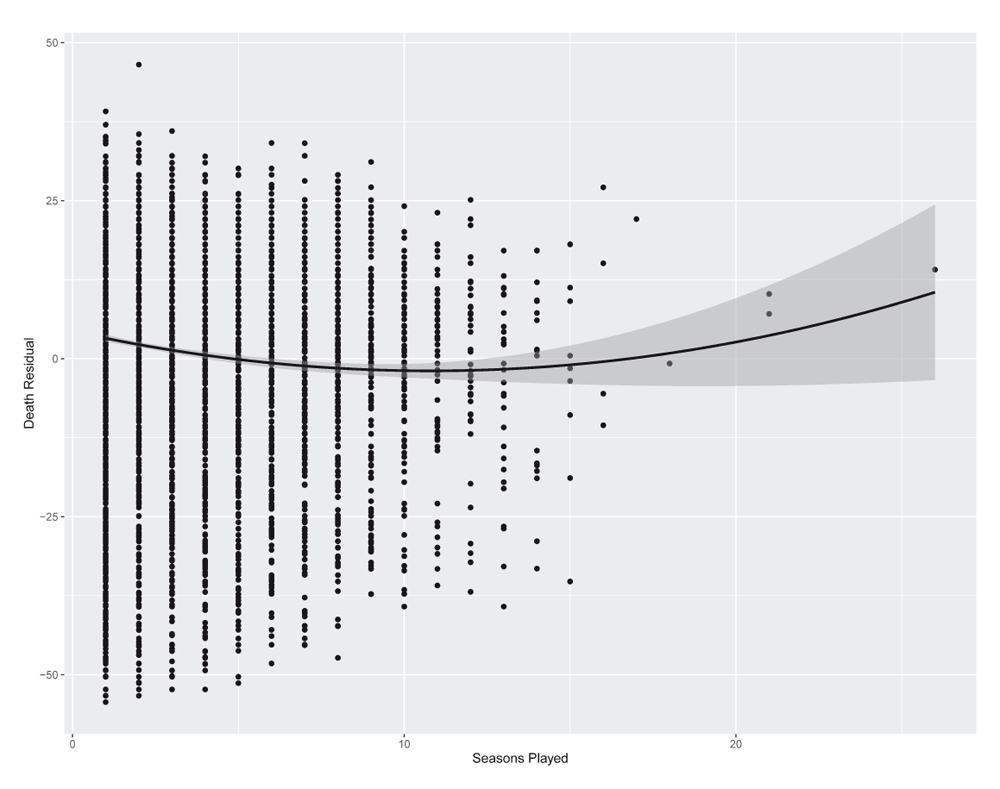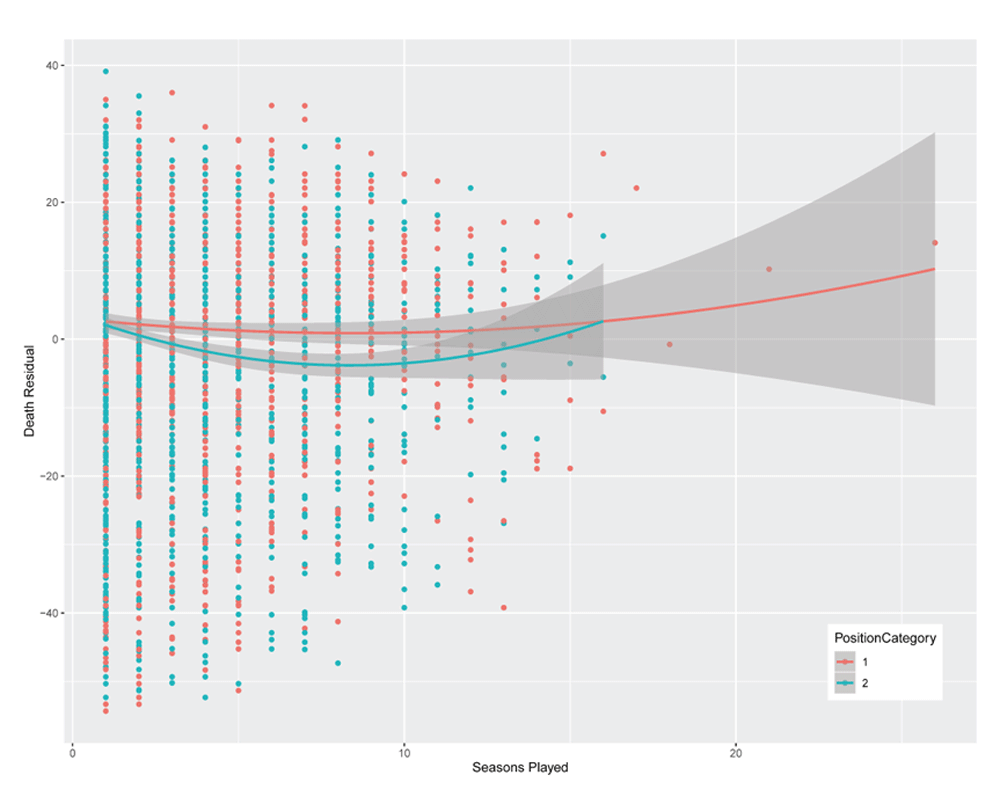Keywords
CTE, concussions, football, gridiron football, NFL, chronic traumatic encephalopathy, sports
CTE, concussions, football, gridiron football, NFL, chronic traumatic encephalopathy, sports
Very little information exists about mortality and long-term health outcomes among National Football League (NFL) players. Elite football players tend to have a lower overall mortality rate than the general population, often attributed to routine physical activity1,2. However, this occupational group cannot be directly compared to the general population3. Several studies in small numbers of NFL players have found an association between traumatic brain injuries with depression, suicide, dementia, and chronic traumatic encephalopathy4–6. There is mounting evidence that even sub-clinical head impacts, especially when they occur frequently, can also lead to these adverse health outcomes7,8. However, these relationships are difficult to study systematically due to few cases, challenges with diagnostics, and long lag time from the injury to symptom onset. Yet, there exists a rich repository of data surrounding NFL career playing statistics9. We hypothesize that certain player career attributes, including position-of-play and seasons-played, are likely to be strong predictors for mortality from repeated, yet mild, head trauma. Here, we study the association between mortality and NFL seasons-played, while controlling for playing position.
Data was collected from Pro Football Reference, a free online database maintained by Sports Reference LLC that includes playing statistics from every player in NFL history, over 25,000 in total, with meticulously recorded data beginning in 19229. Merged and transformed data is available from an open repository10. Variables of interest include birthdate, death date, position, and seasons-played. Individuals with any missing data were eliminated, leaving 24,740 players. Of those, 6,408 (25.9%) had died according to Pro Football Reference, as of July 1, 2018. Playing position was divided into three standard categories according to previous literature11.
Category 1: defensive back, quarterback, wide receiver, and kicker: 1,600 dead/8,415 players (19%).
Category 2: running back, linebacker, tight end: 1,690 dead/7,228 players (23%).
Category 3: offensive and defensive linemen: 3,118 dead/9,097 players (34%).
Expected age-at-death was calculated from the 2017 National Vital Statistics Report12 using average years of life remaining at 20 years of age for the decade of the 20th year plus 20. Age-at-death residuals were calculated as observed age-at-death minus expected age-at-death. This analysis was completed in Stata Version 1413, and data was visualized using R 3.6.114. Associations were assessed using linear regression models with a quadratic term for seasons-played. Specifically, we use (position) fixed-effect ordinary least squares modeling to determine whether associations exist between age-at-death residual, number of NFL seasons-played (squared), and position category fixed effects. In these models, we seek to assess whether career duration exposure relates significantly to age-at-death residual conditional on position-of-play. The healthy worker turning point was calculated using standard differential calculus techniques (i.e., calculating the minimum point of a best fit surface).
Base Model:
Age at Death Residual i,t = β0 + β1Number of Seasons Playedi,t + εi,t
Seasons-played Squared Model:
Age at Death Residual i,t = β0 + β1Number of Seasons Playedi,t + εi,t + β2Number of Seasons Played2i,t + εi,t
Position Category Fixed Effects Model
Age at Death Residual i,t = β0 + β1Number of Seasons Playedi,t + εi,t + β2Number of Seasons Played2i,t + εi,t + β3Position Categoryi + εi,t
Table 1 indicates substantial demographic sample variation between players of different position categories in height, weight, BMI, and age-at-death. Figure 1a-Figure 1b indicate a possible healthy worker effect among players of Category I and II. Certain healthy or durable players can play an increased number of seasons without a corresponding reduction in expected age-at-death as compared to players of shorter career duration3.

Dots represent individual players; Solid line represents a quadratic trend.

Dots represent individual players; Solid line represents a quadratic trend.
The Seasons-played Squared and Position Category Fixed Effects models specify a quadratic term for number of NFL seasons-played. For both models, the coefficient for this variable is significant and improves the model’s explanatory power according to an Anova F-test for difference in overall model significance (F-statistic = 9.95, p-value = 0.0016; F-statistic=10.98, p-value<0.001) (Table 2). We calculate that overall association of age-at-death residual and seasons-played is positive beginning at 10.75 and 10.63 seasons-played for the Seasons-played Squared and Position Category Fixed Effects model, respectively. This demonstrates a healthy worker effect, where certain players are not as prone to play-related mortality risk. For this player subset, the healthy worker effect is sufficiently strong to dominate an observed mortality risk effect, where the latter effect drives the negative relationship between seasons-played and age-at-death residual for those playing fewer than 10.75 (10.63) seasons. The healthy worker effect and the mortality risk effect hold conditional upon position category control variables, where controls exhibit substantial variation in effect upon age-at-death residual as in previous literature11. However, dividing players into three position categories may not sufficiently capture the differing on-field exposures that may contribute to mortality.
This paper finds evidence of both player health risk (in terms of age-at-death residual) for increasing NFL seasons played and healthy worker effects among NFL players. For Category I and II players, the latter effect dominates the former for NFL players with sufficient career survivorship. This effect holds conditional upon position-of-play control variables. Previous research not accounting for the healthy worker effect may not adequately describe mortality risk among NFL players.
We are pursuing additional research to examine the association of on-field playing characteristics with mortality and cause of death among NFL players.
This study was determined by the Syracuse University Institutional Review Board to not be human subjects research and therefore, not to require review and oversight.
Harvard Dataverse: Replication Data for: Mortality Risk Factors among National Football League Players: An Analysis using Player Career and Biometric Data. https://doi.org/10.7910/DVN/WHU4KC10
This project contains the following underlying data:
Football1922_2018.tab (Includes player name, position, year of birth, year of death, death residual, position, position category, and the number of seasons-played.)
Data are available under the terms of the Creative Commons Zero "No rights reserved" data waiver (CC0 1.0 Public domain dedication).
| Views | Downloads | |
|---|---|---|
| F1000Research | - | - |
|
PubMed Central
Data from PMC are received and updated monthly.
|
- | - |
Is the work clearly and accurately presented and does it cite the current literature?
Yes
Is the study design appropriate and is the work technically sound?
Yes
Are sufficient details of methods and analysis provided to allow replication by others?
Yes
If applicable, is the statistical analysis and its interpretation appropriate?
Yes
Are all the source data underlying the results available to ensure full reproducibility?
Yes
Are the conclusions drawn adequately supported by the results?
Yes
Competing Interests: No competing interests were disclosed.
Reviewer Expertise: Economics, Environment, Professional Sports, Pandemics
Is the work clearly and accurately presented and does it cite the current literature?
Partly
Is the study design appropriate and is the work technically sound?
Partly
Are sufficient details of methods and analysis provided to allow replication by others?
Partly
If applicable, is the statistical analysis and its interpretation appropriate?
Partly
Are all the source data underlying the results available to ensure full reproducibility?
Yes
Are the conclusions drawn adequately supported by the results?
Partly
References
1. Nguyen VT, Zafonte RD, Chen JT, Kponee-Shovein KZ, et al.: Mortality Among Professional American-Style Football Players and Professional American Baseball Players.JAMA Netw Open. 2019; 2 (5): e194223 PubMed Abstract | Publisher Full TextCompeting Interests: No competing interests were disclosed.
Reviewer Expertise: quantitative risk assessment; epidemiology; regulatory policy
Alongside their report, reviewers assign a status to the article:
| Invited Reviewers | ||
|---|---|---|
| 1 | 2 | |
|
Version 3 (revision) 10 Sep 20 |
read | |
|
Version 2 (revision) 29 Jul 20 |
read | read |
|
Version 1 28 Nov 19 |
read | read |
Provide sufficient details of any financial or non-financial competing interests to enable users to assess whether your comments might lead a reasonable person to question your impartiality. Consider the following examples, but note that this is not an exhaustive list:
Sign up for content alerts and receive a weekly or monthly email with all newly published articles
Already registered? Sign in
The email address should be the one you originally registered with F1000.
You registered with F1000 via Google, so we cannot reset your password.
To sign in, please click here.
If you still need help with your Google account password, please click here.
You registered with F1000 via Facebook, so we cannot reset your password.
To sign in, please click here.
If you still need help with your Facebook account password, please click here.
If your email address is registered with us, we will email you instructions to reset your password.
If you think you should have received this email but it has not arrived, please check your spam filters and/or contact for further assistance.
Comments on this article Comments (0)